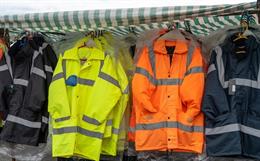Nonwoven materials are gaining popularity across multiple industries due to their lightness and ability to protect against microorganisms. However, sustainability concerns have arisen due to the disposable nature of nonwovens and their potential for environmental pollution. Manufacturers are now diversifying into greener ranges, with a growing interest in bio-based versions. The greatest challenge going forward will be cutting the carbon footprint of nonwovens by switching to organic feedstocks.
Consumers encounter nonwoven materials everyday, making up their clothes, facemasks, cosmetics wipes, and reusable bags.
The popularity of this material owes to its simplicity. Nonwovens are a textile type made from short and long fibres mashed together to bind into a pliable surface. Felt is one of the oldest and simplest examples of a nonwoven fabric but the last fifty years have seen an explosion in different types of this material.
The fibres in nonwovens stick together thanks to one of three manufacturing processes: chemical bonding, heat treatment, or mechanical pressing. Since their fibres are not held together by intricate woven or knitted patterns, the material has certain physical advantages that make them ideal in certain applications.
Nonwovens are cheaper to make than their knitted or woven counterparts because the manufacturing process does not need any yarn input and does not involve any complex weaving processes.
Another physical characteristic driving their popularity is their lightness. As packaging, for example, they are both less voluminous and heavier than woven or knit fabrics, offering comparatively more efficient storage and a reduction in transportation fuel costs.
Nonwovens also protect their contents well from microorganisms. A 2015 study even showed that using nonwoven fabrics compared to woven fabrics reduced the proportion of packaged operating instruments that had to be resterilised after storage.1 This cheap, light material is therefore the default option for protective clothing in healthcare, medicine, and emergency services.
Growing Popularity
Nonwovens are gaining favour across multiple industries. Between 2021 and 2030, the global nonwoven fabrics market size is expected to grow at a CAGR of more than 5 per cent, with the Asia-Pacific market dominating.
Historically, nonwovens in apparel were limited to their function as a reinforcing layer inside interlinings for collars and cuffs. Over time, the fashion applications of nonwovens widened from rigid internal lining and migrated to make up outer portions of apparel. Now, although apparel manufacturers still use it to add stiffness and shape-retention, they also use it to create the front linings of coats.
Driving this trend for using nonwovens in outer layers of clothing were technological advances, particularly the development of types with superior flexibility such as Evolon, Miratec from US company PGI, and Inova from Dupont.2
The lightness, flexibility and insulation provided by modern nonwovens make them an ideal component in all types of clothing applications, but they are particularly suited for sportswear and outdoor performance apparel.3 One good example of a nonwoven material for heavy-duty wear is DuPont’s Tyvek, which gives an outer layer that is water and windproof.
Many companies that supply nonwovens for clothing applications also offer product lines for other sectors and uses. Freudenberg Performance Materials, for example, is one of the biggest manufacturers of this textile type. Alongside nonwovens for clothing and shoes, it produces the material for use as building materials, filtration, hygiene, and medical equipment.4
The Role of The Pandemic in Pushing Demand
The pandemic gave huge stimulus for the nonwoven industry. From 2019 onwards came huge global demand for sterilised consumer goods in hygiene, medical personal protective equipment, and personal care. Lightweight, cheap to produce, and disposable, nonwovens are ideally suited for these applications.
Wipes became the biggest demand application for the nonwoven industry starting in 2019.5 Of course, nonwoven personal protective equipment was high in demand too, so much so that some textile companies repurposed existing manufacturing lines to make more medical materials and face masks.
The lasting effect of this pandemic surge may be that nonwoven manufacturers now have the capacity and expertise to meet growing demand from other segments, even as the medical demand eases off.6
Sustainability Concerns
However, pandemic demand also exacerbated and highlighted problems of waste and environmental pollution associated with this multipurpose material.
Because nonwoven fabrics have a comparatively shorter lifespan than knitted or woven materials, they are often destined for single-use applications, hygiene and medical dressings, packaging, and personal protection equipment.
The sustainability concerns around the material sharpened focus over the pandemic. Hospitals generally output a huge amount of waste in medical textiles as a matter of course but this only heightened from 2020 onwards.7
Although disposable equipment in healthcare is essential to preventing infections, many now want to address the mounting problem of waste with biodegradable alternatives.
This means that a small but growing sub-segment of woven goods are those made from renewable, organic fibres.
There is great scope for a biodegradable nonwoven industry. Nonwovens can be made from a huge diversity of fibres, including those from organic feedstock. These feedstocks for nonwoven fibres now range from more novel options like chitin – a compound found in the shells of sea creatures – to cotton. These biodegradable options offer a viable alternative to petrochemical fibres. Benost is one of the early commercialisers of chitin-based nonwovens.
Yet biodegradable nonwovens remain relative newcomers in an industry dominated by cheap and readily available petrochemical plastic fibres. Around 66 per cent of material use in nonwovens is synthetic.8 This is why most nonwoven items on the market today will not break down readily or safely in the environment.
Unlike in medical applications, clothing applications of nonwovens tend not to be single use. Indeed, nonwoven material in clothing is usually integral to the durability of the clothing item.
Nonetheless, there is now a general drive within fashion to replace petrochemical nonwovens with greener substitutes. Questions around the use of synthetic nonwoven in clothing track a broader trend to replace fossil oil materials like polyester, polypropylene, polyamide (nylon), and rayon with more sustainable materials.
Unfortunately, the world of apparel today is still heavily dependent on these oil sources – not in nonwovens, but in other textiles too.9 Polyester is responsible for around 40 per cent of the fashion industry’s overall emissions,10 being the most widely-used clothing fibre in the world. Nylon comes a close second. Usually, nonwovens in clothing combine both of these.
Renewable Nonwovens: Plant-Based is not Necessarily Greener
In some regions at least, a broader shift towards renewable nonwovens looks plausible. For example, the textiles industry is finding itself having to respond to policy moves such as the European Union Single Use Plastic directives by looking into bio-based and recycled alternatives.
Manufacturers that traditionally sold only petrochemical nonwoven products are already diversifying into greener ranges. Mogul, a Turkish producer, extended its sustainable line in 2022 by offering renewable and biobased nonwovens, including a 100 per cent bio-based polyester that reaches 93.8 per cent biodegradation in 646 days in an accelerated landfill environment.11
However, just because nonwoven fibres are plant-based does not always mean they are greener from either a carbon or environmental waste perspective. Even though some nonwovens today use the fibres of bio-based plastics, most of the bio-plastics on the market today degrade under very specific industrial conditions offered at custom recycling plants.
NatureWORKS’ PLA Ingeo fibre falls into this category, being bio-based but non-readily biodegradable in the natural environment. Although derived from corn maize, its material is still a polymer whose chemical structure closely resembles those of ordinary polyester or polypropylene polymers.
Recycled and Compostable Options
Yet there is room for improving the carbon profile of synthetic nonwovens. Even where nonwovens are made from petrochemical-based fibres, they can be derived from recycled plastics. Again, Mogul has made headway in this area. It announced last year that it would be using a branded textile called Repreve by Unifi made from polyester waste like plastic bottles. Currently in Europe, over 30 per cent of all polyester fibre used is from recycled materials, meaning there is a relatively accessible supply chain for other nonwoven manufacturers to make the switch.12
Meanwhile, smaller startups are pioneering fully compostable nonwoven materials. Bast Fibre Tech produces 100 per cent plant-based natural fibres ready for nonwoven applications that are fully compostable, using such feedstock as hemp, jute, and kenaf.13
Partnerships between specialised bio-based startups and larger players are also emerging in this space, such as the joint venture between global packaging and recycling company ALPLA Group and Blue Ocean Closures, a Swedish startup developing natural fibre-based closures.
Where next?
Fashion’s drive to move away from petrochemicals looks likely to stay. Combined with increasing demand for sustainable materials in other major nonwoven sectors like construction and medical care, the greatest challenge going ahead will be cutting the carbon footprint of this ubiquitous material by switching to organic feedstocks.
Already, established nonwoven manufacturers are showing growing interest in bio-based versions. This tracks the rise of bio-based plastics more broadly, which is expected to grow at a CAGR rate of 14 per cent between 2022 and 2027.14
Promisingly, the expected CAGR rate for bio-based plastics is almost double that for conventional polypropylene nonwoven fabrics during the same period. Further, Fibre2Fashion’s market insight tool TexPro estimates that polyester fibre will reduce to 56.36 from around 57.57 percent by 2025.15
Nonetheless, bio-based nonwovens start from a much smaller market share, meaning that it has a lot of catching up to do to replace fossil derivatives.
Demand for renewable nonwovens will depend on the wider pace of bioplastics scaling. This will be critical for supplying nonwoven textile makers with cheaper inputs that will enable price competitive green products.


 News
News Articles
Articles Interviews
Interviews Events
Events Advertise with us
Advertise with us About Us
About Us Contact Us
Contact Us Privacy Policy
Privacy Policy Terms & Conditions
Terms & Conditions Cookie Policy
Cookie Policy




_small.png)




